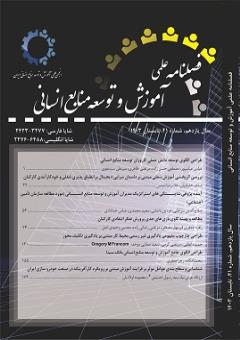طراحی الگوی جامع آموزش و توسعه منابع انسانی بانک سینا
محورهای موضوعی : روش های نوین آموزش وتوسعه منابع انسانی
1 - استادیاردانشکده علوم انسانی دانشگاه شاهد،تهران
2 - کارشناسی ارشد مدیریت دولتی دانشگاه شاهد،تهران
کلید واژه: الگوی جامع آموزش, توسعه منابع انسانی, نظام آموزش بانک, آموزش و بهسازی, بانک سینا,
چکیده مقاله :
با توجه به تغییرات فزاینده و محیط رقابتی، سازمانها باید به طور فعال بر روی آموزش و توسعه کارکنان با هدف اصلی دستیابی به افزایش بهره وری، سودآوری، مزیت رقابتی و رشد پایدار سرمایه گذاری کنند. هدف اصلی اين پژوهش طراحی الگوی جامع آموزش و توسعه منابع انسانی براي بانک سینا بوده است. روش تحقیق پژوهش از نوع کیفی و تحلیل مضمون میباشد. برای گردآوری دادهها از دو روش کتابخانهای و میدانی استفاده شد. دادههای مورد نیاز در روش کتابخانه ای با جستجو درسایتها و پایگاههای تحقیقاتی مختلف، مطالعه اسناد و منابع علمی و در بخش میدانی، از مصاحبه نیمه ساختاریافته با خبرگان، مدیران و کارشناسان آموزش به دست آمد. جامعه آماری شامل مدیران، اساتید، متخصصان و برنامه ریزان حوزه آموزش وكارشناسان منابع انساني بود که با استفاده از اصل اشباع نظري و روش نمونهگیری هدفمند تعداد 10 نفر انتخاب شدند. در این پژوهش با استفاده از روش تحلیل مضمون، تعداد 186 گزاره استخراج و کدگذاری گردید و مضامین در سه دسته مقوله اصلی، مقوله فرعی و زیر مقوله فرعی طبقه بندی شدند. براساس نتایج حاصل از پژوهش، الگوی آموزش و توسعه منابع انسانی بانک سینا طراحی گردید که شامل سه مقوله اصلی درونداد، فرآیند و برونداد است. مقوله اصلی درونداد به سه مقوله فرعی مدیران عالی حامی آموزش، تدوین استراتژی و جایگاه فرهنگ یادگیری و توسعه تقسيم شد. مقوله اصلی فرآیند نیز به سه مقوله فرعی شناسایی نیازها، برنامهریزی آموزش و اجرای آموزش و مقوله اصلی برونداد به دو مقوله فرعی ارزیابی و نتایج طبقه بندی گردید.
Organizations must proactively invest in employee training and development to navigate the ever-evolving landscape and remain competitive. The primary objectives of such initiatives include boosting productivity and profitability, gaining a competitive edge, and ensuring sustainable growth. Accordingly, this study aimed to develop a comprehensive model for training and developing human resources in Sina Bank. A qualitative research approach based on thematic analysis was therefore adopted. Data collection involved both bibliographic research and fieldwork. The bibliographic research involved searches across diverse research platforms and databases, along with an examination of scholarly documents and sources. The fieldwork included semi-structured interviews with experts, administrators, and education professionals. The study's statistical population consisted of administrators, professors, specialists, and planners within the education and human resources domains. The participants were selected through purposive sampling method and continued until theoretical saturation of data. The theme analysis approach was utilized, resulting in the extraction and coding of 186 statements, which were subsequently organized into three overarching categories: The main category, sub-category, and sub-sub-category. The research outcomes culminated in the design of Sina Bank's human resources training and development model, comprising three primary categories: Input, process, and output. The input category consisted of three sub-categories: Top managers' support for education, formulation of strategies, and the fostering of a learning and development culture. The process category was divided into three sub-categories: Needs identification, education planning, and education implementation. Finally, the output category encompassed two sub-categories: Evaluation and results.
